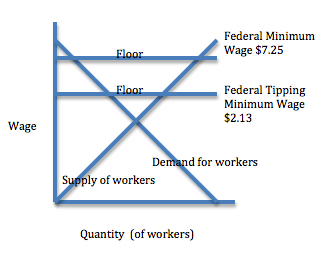
Back to the Future… of Air Travel
August 13, 2014
How Music Can Empower You
August 15, 2014Most of us don’t give a bigger tip for better service.
A Cornell Hotel School professor who studies tipping has observed the impact of service, attractiveness and “technique.” Equal to a 4% fluctuation in the size of a tip, the correlation between service quality and tip size is minimal. What counts more for women is being attractive, blonde, in their 30s and slender while men’s looks seem not to matter. At the end of the meal, servers who briefly touch the shoulders of diners when giving them a check get higher tips. Giving candy at the end of a meal also makes a difference as do smiley faces on checks but only from females.
So where are we going with this? To the tipping minimum wage and an economic floor.
Tipping Minimum Wage
Until recently, I didn’t know there is a tipping minimum wage. While the federal minimum wage is $7.25, the federal tipped minimum wage is $2.13.
As the businesses with employees who get 70% of all tips in the U.S., restaurants have been the focus of the tipping debate. Some point out that a low tipped minimum wage lets restaurants decrease what they charge diners or increase their profits. But I suspect the real issue is the unpredictability of tips and the varied response from states. California and Nevada, for example, mandate their own tipped minimum wage while others like New Jersey and Texas remained with the federal minimum.
Here you can see how the state-by-state tipping debate has unfolded:

From: WSJ
The Bottom Line… Or, the Economic Floor.
Below, I’ve drawn 2 floors on a supply and demand graph. In the graph, the upward sloping supply curve represents workers who are willing and able to provide more labor at a higher wage while the downward sloping demand curve is the employers, happy to hire more people when wages are lower. Called floors because they prevent wages from moving further downward, the horizontal lines create job shortages and worker surpluses because they cross the employers’ demand curve before they get to the workers’ supply curve (at a higher quantity).

Our bottom line: So, whenever we look at a minimum wage, we are talking about an economic floor.
![econlifelogotrademarkedwebsitelogo[1]](/wp-content/uploads/2024/05/econlifelogotrademarkedwebsitelogo1.png#100878)



